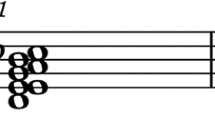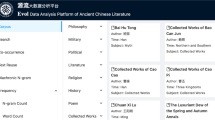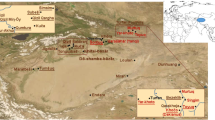Abstract
The corpus of Old English verse is an indispensable source for scholars of the Indo-European tradition, early Germanic culture and English literary history. Although it has been the focus of sustained literary scholarship for over two centuries, Old English poetry has not been subjected to corpus-wide computational profiling, in part because of the sparseness and extreme fragmentation of the surviving material. Here we report a detailed quantitative analysis of the whole corpus that considers a broad range of features reflective of sound, metre and diction. This integrated examination of fine-grained features enabled us to identify salient stylistic patterns, despite the inherent limitations of the corpus. In particular, we provide quantitative evidence consistent with the unitary authorship of Beowulf and the Cynewulfian authorship of Andreas, shedding light on two longstanding questions in Old English philology. Our results demonstrate the usefulness of high-dimensional stylometric profiling for fragmentary literary traditions and lay the foundation for future studies of the cultural evolution of English literature.
This is a preview of subscription content, access via your institution
Access options
Access Nature and 54 other Nature Portfolio journals
Get Nature+, our best-value online-access subscription
$29.99 / 30 days
cancel any time
Subscribe to this journal
Receive 12 digital issues and online access to articles
$119.00 per year
only $9.92 per issue
Buy this article
- Purchase on Springer Link
- Instant access to full article PDF
Prices may be subject to local taxes which are calculated during checkout




Similar content being viewed by others
Data availability
All datasets are freely and publicly available at https://github.com/qcrit.
Code availability
All custom code is freely and publicly available at https://github.com/qcrit.
References
Fulk, R. & Cain, C. A History of Old English Literature 2nd edn (Wiley-Blackwell, 2013).
Tolkien, J. Beowulf: the monsters and the critics. Proc. Br. Acad. 22, 245–295 (1936).
Clark, D. & Perkins, N. Anglo-Saxon Culture and the Modern Imagination (D. S. Brewer, 2010).
Biber, D. & Conrad, S. Register, Genre, and Style (Cambridge Univ. Press, 2009).
Amos, A. C. Linguistic Means of Determining the Dates of Old English Literary Texts (Medieval Academy of America, 1980).
Jockers, M. Macroanalysis: Digital Methods and Literary History (Univ. Illinois Press, 2013).
Long, H. & So, R. Literary pattern recognition: modernism between close reading and machine learning. Crit. Inq. 42, 235–267 (2016).
Chaudhuri, P. & Dexter, J. P. Bioinformatics and classical literary study. Journal of Data Mining & Digital Humanities Special Issue on Computer-Aided Processing of Intertextuality in Ancient Languages https://jdmdh.episciences.org/paper/view?id=3807 (2017).
Dexter, J. et al. Quantitative criticism of literary relationships. Proc. Natl Acad. Sci. USA 114, E3195–E3204 (2017).
Barquist, C. Phonological patterning in Beowulf. Lit. Linguist. Comput. 2, 19–23 (1987).
Barquist, C. & Shie, D. Computer analysis of alliteration in Beowulf using distinctive feature theory. Lit. Linguist. Comput. 6, 274–280 (1991).
Drout, M. D., Kahn, M. J., LeBlanc, M. D. & Nelson, C. Of dendrogrammatology: lexomic methods for analyzing relationships among Old English poems. J. Eng. Ger. Philol. 110, 301–336 (2007).
García, A. M. & Martín, J. C. Function words in authorship attribution studies. Lit. Linguist. Comput. 22, 49–66 (2007).
Gill, P., Swartz, T. & Treschow, M. A stylometric analysis of King Alfred’s literary works. J. Appl. Stat. 34, 1251–1258 (2007).
Drout, M., Kisor, Y., Smith, L., Dennett, A. & Piirainen, N. Beowulf Unlocked: New Evidence from Lexomic Analysis (Palgrave Macmillan, 2016).
Shippey, T. in A Beowulf Handbook (eds Bjork, R. & Niles, J.) 159–168 (Univ. Nebraska Press, 1998).
Neidorf, L. The Transmission of Beowulf (Cornell Univ. Press, 2017).
Bjork, R. Cynewulf: Basic Readings (Garland Publishing, 1996).
Orchard, A. in Anglo-Saxon Styles (eds Karkov, C. & Brown, G.) 271–305 (State Univ. New York Press, 2003).
Puskar, J. Questioning Cynewulf’s claim of authorship. Eng. Stud. 92, 1–19 (2011).
Mesoudi, A. Pursuing Darwin’s curious parallel: prospects for a science of cultural evolution. Proc. Natl Acad. Sci. USA 114, 7853–7860 (2017).
Grieve, J. Quantitative authorship attribution: an evaluation of techniques. Lit. Linguist. Comput. 22, 251–269 (2007).
Forstall, C., Jacobson, S. & Scheirer, W. Evidence of intertextuality: investigating Paul the Deacon’s Angustae Vitae. Lit. Linguist. Comput. 26, 285–296 (2011).
Koppel, M., Schler, J. & Argamon, S. Computational methods in authorship attribution. J. Assoc. Inf. Sci. Technol. 60, 9–26 (2009).
Sapkota, U., Bethard, S., Montes, M. & Solorio, T. Not all character n-grams are created equal: a study in authorship attribution. In Proc. 2015 Conference of the North American Chapter of the Association for Computational Linguistics: Human Language Technologies 93–102 (Association for Computational Linguistics, 2015).
Neidorf, L. The dating of Widsith and the study of Germanic antiquity. Neophilologus 97, 165–183 (2013).
Klaeber, F. The Christian Elements in Beowulf (Medieval Institute Publications, 1996).
Brodeur, A. The Art of Beowulf (Univ. California Press, 1959).
Irving, E. A Reading of Beowulf (Yale Univ. Press, 1968).
Schücking, L. L. Beowulfs Rückkehr: Eine Kritische Studie (M. Niemeyer, Halle, 1906).
Magoun, F. P. in Early English and Norse Studies Presented to Hugh Smith in Honour of his Sixtieth Birthday (eds Brown, A. & Foote, P.) 127–140 (Methuen, 1963).
Kiernan, K. S. Beowulf and the Beowulf Manuscript (Rutgers Univ. Press, 1981).
Liuzza, R. M. in Beowulf: Basic Readings (ed. Baker, P.) 281–302 (Garland Publishing, 1995).
Fitch, J. Sense-pauses and relative dating in Seneca, Sophocles and Shakespeare. Am. J. Philol. 102, 289–307 (1981).
Kuhn, H. Zur Wortstellung und -betonung im Altgermanischen. Beitr. Gesch. Dtsch. Sprache Lit. 57, 1–109 (1933).
Momma, H. The composition of Old English poetry. Lang. Lit. 7, 175–178 (1998).
Nagy, G. Homer’s Text and Language (Univ. Illinois Press, 2004).
West, M. L. The Making of the Iliad: Disquisition and Analytical Commentary (Oxford Univ. Press, 2011).
Sievers, E. Altgermanishe Metrik (M. Niemeyer, Halle, 1893).
Gardner, T. The Old English kenning: a characteristic feature of Germanic poetical diction? Mod. Philol. 67, 109–117 (1969).
Bosworth, J. An Anglo-Saxon Dictionary (Clarendon Press, 1989).
Cook, A. S. The Christ of Cynewulf: A Poem in Three Parts: the Advent, the Ascension and the Last Judgment (Ginn and Company, 1900).
Diamond, R. E. The diction of signed poems in Cynewulf. Philolog. Q. 38, 228–241 (1959).
Schaar, C. Critical Studies in the Cynewulf Group (Haskell House, 1967).
Fulk, R. in Cynewulf: Basic Readings (ed. Bjork, R. E.) 3–22 (Garland Publishing, 1996).
Bjork, R. E. The Old English Poems of Cynewulf (Cambridge Univ. Press, 2013).
Stodnick, J. A. Cynewulf as author: medieval reality or modern myth? Bull. J. Rylands Univ. Libr. 79, 25–39 (1997).
Carr, C. T. Nominal Compounds in Germanic (St. Andrews Univ., 1939).
Terasawa, J. Nominal Compounds in Old English: A Metrical Approach (Rosenkilde & Bagger, 1994).
Jockers, M. L. & Underwood, T. in A New Companion to Digital Humanities 2nd edn (eds Schreibman, S., Siemens, R. & Unsworth, J.) 291–306 (Wiley-Blackwell, 2016).
Greenberg, J. H. A quantitative approach to the morphological typology of language. Int. J. Am. Ling. 26, 178–194 (1960).
O’Donoghue, H. Old Norse-Icelandic Literature: A Short Introduction (Wiley-Blackwell, 2004).
Bhrolchain, M. N. An Introduction to Early Irish Literature (Four Courts Press, 2017).
Zink, M. Medieval French Literature: An Introduction (Medieval and Renaissance Texts and Studies, 1995).
Dimock, W. C. Low epic. Crit. Inq. 39, 614–631 (2013).
Russom, G. Old English Meter and Linguistic Theory (Cambridge Univ. Press, 1987).
Acknowledgements
The authors thank M. Nowak, S. Sinai and J. Gerold for helpful conversations, as well as S. Pintzuk and G. Russom for assistance in obtaining texts, dictionaries and scansions in formats amenable to computational analysis. This work was conducted under the auspices of the Quantitative Criticism Lab (www.qcrit.org), an interdisciplinary project co-directed by P.C. and J.P.D. and supported by a Neukom Institute for Computational Science CompX Grant and a National Endowment for the Humanities Digital Humanities Start-Up Grant (HD-248410-16). P.C. was supported by a New Directions Fellowship from the Andrew W. Mellon Foundation, and J.P.D. was supported by a National Science Foundation Graduate Research Fellowship (DGE1144152) and a Neukom Fellowship. The Program for Evolutionary Dynamics is supported in part by a gift from B. Wu and E. Larson. The funders had no role in study design, data collection and analysis, decision to publish or preparation of the manuscript.
Author information
Authors and Affiliations
Contributions
L.N., M.S.K., P.C. and J.P.D. designed the study. M.S.K., M.Y. and J.P.D. performed the study. All authors analysed the results. L.N., M.S.K., P.C. and J.P.D. wrote the manuscript, which was read and approved by all authors.
Corresponding authors
Ethics declarations
Competing interests
The authors declare no competing interests.
Additional information
Publisher’s note: Springer Nature remains neutral with regard to jurisdictional claims in published maps and institutional affiliations.
Supplementary information
Supplementary Information
Supplementary Figures 1–5 and Supplementary Table 1.
Rights and permissions
About this article
Cite this article
Neidorf, L., Krieger, M.S., Yakubek, M. et al. Large-scale quantitative profiling of the Old English verse tradition. Nat Hum Behav 3, 560–567 (2019). https://doi.org/10.1038/s41562-019-0570-1
Received:
Accepted:
Published:
Issue Date:
DOI: https://doi.org/10.1038/s41562-019-0570-1
This article is cited by
-
Andreas, Intertextuality, and Three Modes of Philology: Traditional, Oral, Digital
Neophilologus (2023)
-
Computational authorship analysis of the homeric poems
International Journal of Digital Humanities (2022)
-
Reply to: Beowulf single-authorship claim is unsupported
Nature Human Behaviour (2021)
-
Beowulf single-authorship claim is unsupported
Nature Human Behaviour (2021)



